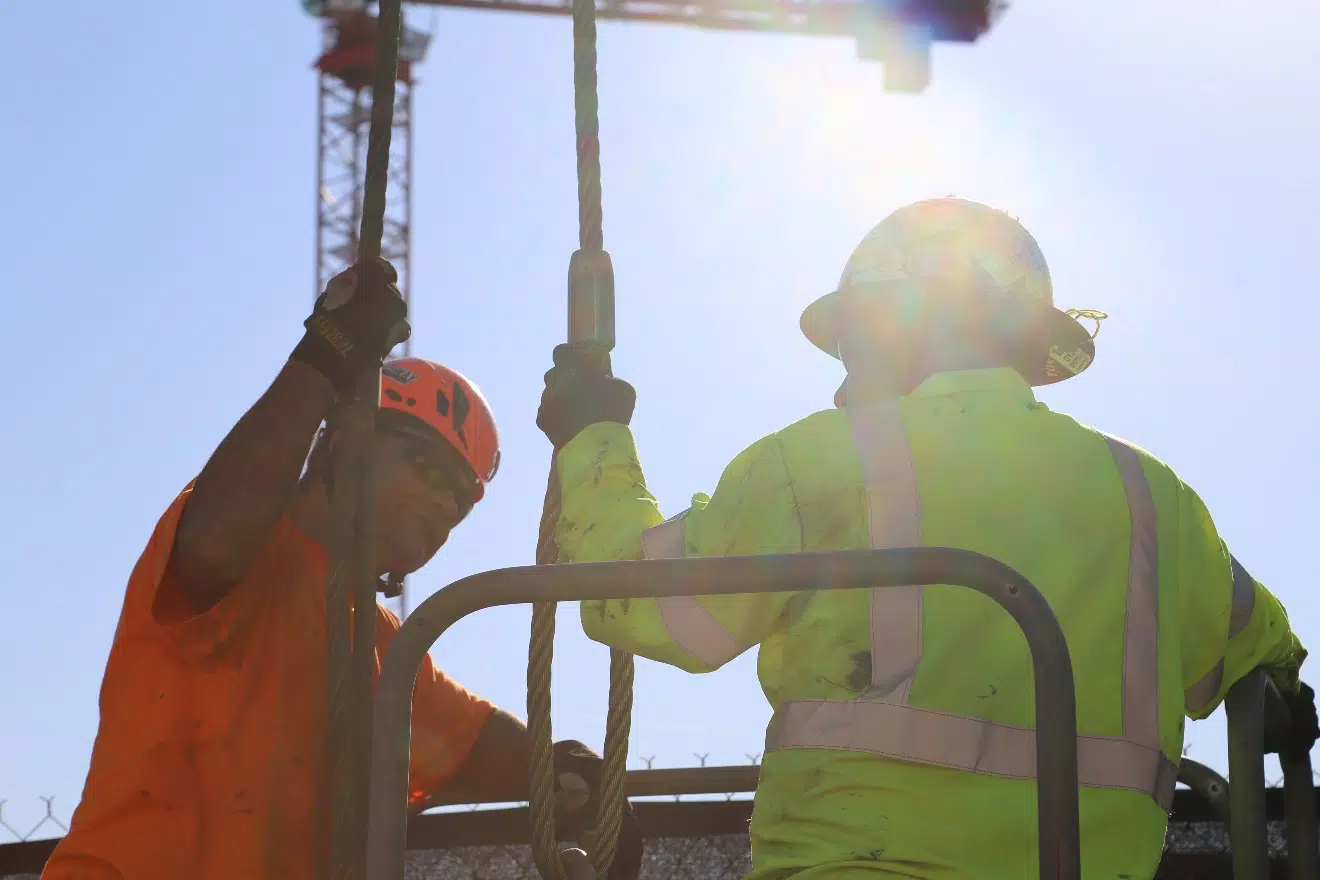In the world of heavy lifting and crane operations, rigging equipment is the cornerstone of successful construction and industrial projects. The right rigging equipment not only facilitates the efficient movement of heavy loads but also plays an important role in meeting project timelines and optimizing cost-effectiveness. Understanding the various types of rigging equipment available and their specific applications can greatly enhance the efficiency and effectiveness of your operations.
Rigging equipment encompasses a wide range of tools and equipment designed to assist in lifting, moving, and securing heavy objects. From slings and shackles to hooks and spreaders, each piece serves a unique purpose and offers distinct advantages in various lifting scenarios. Here is an overview into crane rigging and the different types of rigging equipment you need for a successful project.
Understanding Load Weight and Rigging Equipment
Efficient rigging operations begin with accurately determining the load weight. Manufacturers and shippers often provide this data on equipment nameplates, shipping documents, or engineering blueprints, which should always be the primary source.
In situations where this information is unavailable, it may be possible to estimate a weight by calculating the load’s volume and multiplying it by the material’s density. The weight of a load is necessary for selecting and utilizing the appropriate rigging equipment.
Rigging hardware encompasses a variety of tools designed to facilitate the lifting and movement of these loads. This equipment includes hoists, winches, slings, shackles, and spreaders, each serving specific functions in crane operations and heavy lifting projects. These tools are used for distributing the weight of the load and enabling efficient movement across various applications, from construction to manufacturing.
Types of Crane Rigging Hardware
Hoists and Winches
Hoists and winches are fundamental components in heavy lifting operations, providing the mechanical advantage required to lift and move substantial loads. Mechanical advantage refers to the use of machinery to make lifting easier by multiplying the input force.
Types of Hoists
- Manual Hoists: Operated by hand, manual hoists are ideal for smaller loads and situations where precision is needed. They are portable and do not require an external power source, making them versatile for various applications.
- Electric Hoists: Powered by electricity, these hoists are suitable for lifting heavier loads with ease and speed. They offer higher lifting capacities and are commonly used in industrial settings where power sources are readily available.
- Air-Powered Hoists: Also known as pneumatic hoists, these are driven by compressed air. They are preferred in environments where electrical equipment could pose a hazard, such as in chemical plants or oil refineries.
Applications and Benefits
Hoists are utilized in lifting heavy materials and machinery, allowing for precise control over the lifting process. They offer high lifting capacities tailored to specific loads. The choice between manual, electric, or air-powered hoists depends on the nature of the project, load weight, and jobsite conditions.
Winches are designed to pull heavy loads horizontally over surfaces. They serve a primary function for moving heavy equipment or materials across construction sites or industrial facilities. Both hoists and winches contribute to increased efficiency by reducing manual labor and improving load handling precision.
Slings
Slings are important rigging equipment for securing loads during lifting operations. They act as the connecting medium between the lifting device and the load, providing stability throughout the process.
Types of Slings
- Chain Slings: Made from alloy steel chains, these slings are robust and durable, capable of handling heavy loads and withstanding harsh conditions. They are suitable for high-temperature applications and are resistant to wear and tear from friction, also known as abrasion.
- Wire Rope Slings: Composed of multiple wires twisted into strands, wire rope slings offer flexibility and strength. They are ideal for lifting uneven or bulky loads and are commonly used in construction and offshore operations.
- Synthetic Slings: Crafted from materials like nylon or polyester, synthetic slings are lightweight with a high strength-to-weight ratio. They are gentle on delicate surfaces and adaptable to various load shapes.
Applications and Advantages
Slings are employed to securely attach loads to lifting equipment. Their versatility allows adaptation to different load shapes and weights, making them indispensable in various lifting scenarios. They distribute weight evenly and help prevent damage to the load. The choice of sling type depends on factors such as load weight, shape, temperature, and environmental conditions.
Shackles and Hooks
Shackles and hooks are rigging hardware that play a vital role in facilitating the connection between slings, ropes, chains, and the load.
Types of Shackles
- Anchor Shackles: Featuring a rounded “O” shape, anchor shackles are versatile and allow for multi-directional loading. They are commonly used in connections where load angles may vary.
- Bow Shackles: Similar to anchor shackles but with a larger bow or loop, bow shackles provide greater surface area for multi-sling connections, reducing stress on the slings.
Types of Hooks
- Master Hooks: Designed for heavy loads, master hooks are used in conjunction with chain slings and can handle multiple sling legs simultaneously.
- Swiveling Hooks: Equipped with a swivel mechanism, these hooks can rotate, preventing twisting of the slings or ropes during lifting operations.
Role and Benefits
Shackles and hooks are integral to creating secure connections in rigging equipment setups. Their strength and reliability are paramount in load management, providing confidence in the stability of the lifted objects. Manufactured to withstand significant stress, they are available in various sizes and capacities to suit different applications.
Rigging Hardware and Accessories
Beyond the primary rigging equipment, a variety of hardware and accessories enhance the functionality and adaptability of rigging systems.
Integral Hardware
- Swivels: Allow for rotation of the load without twisting the rigging lines, aiding in proper load alignment.
- Wire Rope Grips: Used to form temporary or permanent loops in wire ropes, providing secure attachments.
- Eye Bolts: Threaded bolts with a looped head shaped like an eye, used as anchor points for lifting or securing loads.
Uses and Advantages
These accessories contribute to increased flexibility and durability in rigging systems. They enable customization of rigging equipment setups to meet specific project needs. By incorporating the appropriate hardware, lifting angles, load distribution, and connection points can be optimized, enhancing overall efficiency.
Rigging Frames and Spreaders
Rigging frames and spreaders are designed to distribute loads evenly during lifting, especially in complex or heavy lifting scenarios.
Rigging Frames
Also known as lifting frames, these structures support loads from multiple points, allowing for balanced lifting of large or irregularly shaped objects. They are necessary when single-point lifting would cause undue stress or instability.
Spreaders
Spreaders are beam-like devices used to convert lifting loads from a single point to multiple points. They distribute the load across a wider area, reducing stress on the lifting equipment and the load itself.
Applications and Benefits
Rigging frames and spreaders play a primary role when lifting large platforms, vessels, or equipment with multiple attachment points. They improve load balance, minimize the risk of deformation (changes in the shape of the load due to stress), and enhance control during lifting. By distributing weight effectively, they contribute to more efficient heavy lifting operations.
Pulleys and Block Systems
Pulleys and block systems are mechanical devices that increase lifting capacity and change the direction of force, optimizing lifting operations.
Pulley Systems
Pulleys consist of a wheel with a grooved rim through which a rope or chain passes. They are used singly or in combination to lift loads with less effort.
Block and Tackle Systems
A combination of pulleys (blocks) and ropes or chains (tackle), these systems provide significant mechanical advantage. They allow heavy loads to be lifted with reduced input force by multiplying the applied force.
Uses and Advantages
Pulleys and block systems are utilized to redirect force and multiply lifting capacity. Vital where space constraints or load weight make direct lifting impractical, they reduce manual effort, increase efficiency, and decrease fatigue, contributing to smoother operations.
Specialized Rigging Equipment
For unique project requirements, specialized rigging equipment offers tailored solutions to meet specific heavy lifting challenges.
Lifting Beams
Horizontal beams that attach to cranes, providing multiple lifting points. They stabilize loads that are too long or flexible to be lifted safely from a single point.
Turnbuckles
Adjustable devices used to tension rigging systems, allowing fine-tuning of rigging lines for precise control over the load.
Load Indicators
Devices providing real-time feedback on load weight, aiding in monitoring lifting operations within equipment capacity limits.
Applications and Benefits
Specialized equipment enables customization of rigging equipment setups to address complex lifting scenarios. Enhancing precision and control, they allow loads to be handled appropriately according to their specific characteristics.
Maxim Crane’s Rigging Equipment Solutions
Maxim Crane offers an extensive range of rigging equipment tailored to diverse industry lifting requirements. With a nationwide presence and a commitment to excellence, Maxim Crane provides:
- Engineered Rigging Solutions: Skilled assistance in selecting the right equipment for your specific project needs.
- Wide Range of Equipment: An extensive inventory of rigging equipment, from hooks and slings to shackles and specialized below the hook tools.
- Nationwide Availability: With a presence across the country, Maxim Crane provides easy access to equipment and support.
- Professional Consultation: Knowledgeable professionals ready to assist with planning and executing heavy lifting operations.
Maxim Crane has a proven track record in supporting successful projects across various sectors. Clients benefit from reliable rigging equipment and knowledgeable guidance, contributing to efficient and effective operations.
Find the Right Equipment Rigging and Crane for Your Project

Rigging equipment is the backbone of heavy lifting and crane operations in construction and industrial projects. Understanding the functionalities and applications of various rigging equipment is necessary for optimizing efficiency and effectiveness. From hoists and winches to slings and shackles, each piece of rigging equipment plays a role in the safe and efficient movement of heavy loads.
Selecting the right rigging equipment for specific heavy lifting needs enhances operational performance and supports project timelines and budgets. Maxim Crane stands ready to provide the experience and resources necessary for successful heavy lifting projects.
Reach out to Maxim Crane team today to explore how our nationwide fleet and engineered rigging solutions can make your next heavy lifting project efficient and successful. Discover the difference that quality equipment and professional support can make in achieving your project goals.



